But First, Tea
There’s nothing like the spicy warmth of masala chai. While some premade masalas aren’t great, you can easily create your own fresh masala mix with a handful of spices. There are several tried-and-true methods of making stellar chai.
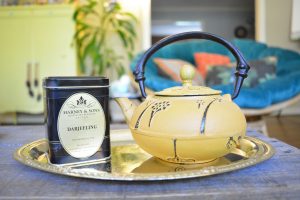
Harney and Sons Darjeeling Tea © Heart of Pixie
I recently used a spice grinder to make a big batch of masala that has kept fresh in a glass jar. Before that, though, I would just bruise the herbs, toss them all in the pot, and then strain them after steeping. Either way yields yummy results, though the more freshly ground or bruised herbs always taste best.
Here’s what I used for my masala mix, good for about 8- 10 cups. Everyone has a slightly different preference when it comes to masala, so you might want to use fewer/more to taste.
Masala Mix
5-6 Cardamom Pods
1-2 Cinnamon sticks, or 1 tablespoon ground cinnamon
1/2 Nutmeg, or 1/2 teaspoon ground nutmeg
2-3 Peppercorns
2-3 Cloves
5-6 Anise Seeds (or from 1-2 pods)
1-2 Saffron strands
Add: 1/4 inch freshly-cut ginger

Masala Mix: Cinnamon, cardamom pods (crushed if using whole herbs, but just the seeds if grinding), cloves, nutmeg, peppercorns, star anise. © Heart of Pixie
The Chai–Darjeeling
While many folks use regular Lipton tea or another inexpensive brand (since the quality isn’t of utmost importance, really, since the masala is going to make it all taste good), I really wanted to use loose-leaf, and I wanted to try Darjeeling, since I’ve already had Assam, and those are the two I’ve seen most often associated with Indian masala chai.
I decided to go with loose-leaf Darjeeling from U.S.-based Harney and Sons, and I found this tea to be of good quality and of a delicate, slightly orange-y or apricot flavour. This was the first Darjeeling I’ve had (at least since I’ve started paying attention to what kind of tea I’m drinking), so I’m not sure how it compares. I’ve read that Darjeeling tends to have a very unique and pronounced flavour, but this one is really subtle. I like it, though, and I plan to read this book to learn more.
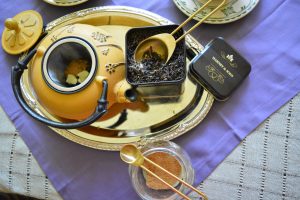

I steeped 1 tablespoon of tea, together with 1 teaspoon of my spice mix and about 1/4 teaspoon of freshly-cut ginger, for 5 minutes. In this little pot the two of us had enough to refill our tea cups twice each.
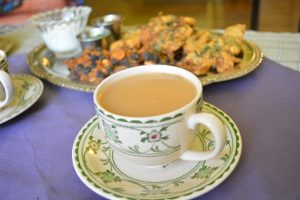
For the snacks, I made my home-honed pakora recipe that I’m going to share with you today, as well as another of Chetna Makan’s recipes from The Cardamom Trail. Since I have tapioca on hand for a future post, I tried the Tapioca Vadas. I think perhaps she uses white tapioca pearls, because her pictures definitely don’t have such conspicuous dark balls as mine ended up having. Despite the look, they do taste good, and the peanut flavour works really well with the tapioca and potato. I’m going to try these again.

Top: Cauliflower, Potato, and Onion Pakoras
Bottom: Tapioca Vadas
With: Yoghurt & Mint and Onion chutneys © Heart of Pixie
In the meantime, here’s my basic pakora recipe with cauliflower, potato, and onion:
Cauliflower-Potato Pakoras
1 1/2 cups of besan (chickpea) flour*
1 cup water*
1 teaspoon baking powder
2-3 teaspoons chili powder
1 head cauliflower, chopped into floweretts
1-2 red potatoes, sliced
1/3 onion, chopped
1 large handful of cilantro, chopped

pinch of salt
canola oil, for frying
*You may have to alter the besan-to-water ratio for your desired consistency. Also, when I want pakoras and don’t have store-bought besan flour, I grind garbanzo beans using a spice or coffee grinder with beautiful results. One day I’ll do a comparison post.
- Mix dry ingredients in a bowl.
- Add water until just stirrable, kind of like pancake batter.
- Add cilantro.
- Add veggies and mix.
- Heat about 1 1/2″ oil until a small drop of batter sizzles when it makes contact.
- Add spoonfuls of pakora mix, and fry until golden brown, flipping once. (About 2 minutes each side.)
- Using a slotted spoon, remove pakora from oil and let drain on paper towel-covered newspaper.
- Serve with chutneys and yoghurt. Makes about 20 pakoras.
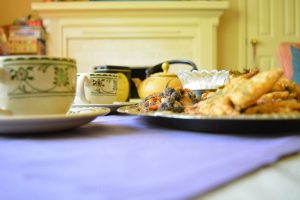
Enjoy! What’s your favorite Indian tea snack? Please let me know in the comments!
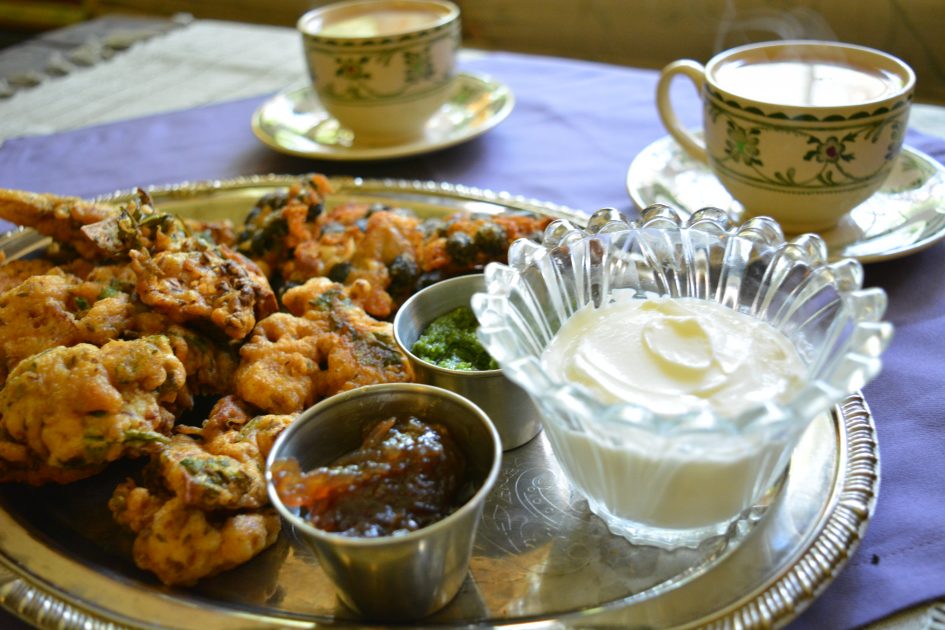

May 8, 2018 at 6:42 pm
I don’t know what my favorite Indian tea snack is but I do love Indian food. I also love Chai. Two of my favorites together at last. This is my first time having Chai-Darjeeling and I enjoyed every sip. If you grind and make your own Masala to make some Chai, I don’t think you’ll believe another Chai to be worthy of comparison.
May 11, 2018 at 2:34 pm
I agree that freshly-ground masala has no comparison!!